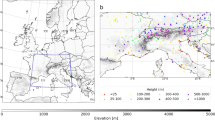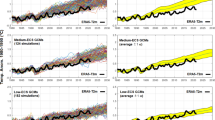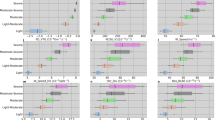Abstract
Synoptic activity over the Northern Hemisphere is evaluated in ensembles of ECHAM5/MPI-OM1 simulations for recent climate conditions (20C) and for three climate scenarios (following SRES A1B, A2, B1). A close agreement is found between the simulations for present day climate and the respective results from reanalysis. Significant changes in the winter mid-tropospheric storm tracks are detected in all three scenario simulations. Ensemble mean climate signals are rather similar, with particularly large activity increases downstream of the Atlantic storm track over Western Europe. The magnitude of this signal is largely dependent on the imposed change in forcing. However, differences between individual ensemble members may be large. With respect to the surface cyclones, the scenario runs produce a reduction in cyclonic track density over the mid-latitudes, even in the areas with increasing mid-tropospheric activity. The largest decrease in track densities occurs at subtropical latitudes, e.g., over the Mediterranean Basin. An increase of cyclone intensities is detected for limited areas (e.g., near Great Britain and Aleutian Isles) for the A1B and A2 experiments. The changes in synoptic activity are associated with alterations of the Northern Hemisphere circulation and background conditions (blocking frequencies, jet stream). The North Atlantic Oscillation index also shows increased values with enhanced forcing. With respect to the effects of changing synoptic activity, the regional change in cyclone intensities is accompanied by alterations of the extreme surface winds, with increasing values over Great Britain, North and Baltic Seas, as well as the areas with vanishing sea ice, and decreases over much of the subtropics.









Similar content being viewed by others
References
Barring L, von Storch H (2004) Northern European Storminess since about 1800. Geophys Res Lett 31: L20202, doi: 10.1029/2004GL020441, 1–4
Beersma JJ, Rider KM, Komen GK, Kaas E, Kharin VV (1997) An analysis of extra-tropical storms in the North Atlantic region as simulated in a control and 2 × CO2 time-slice experiment with a high-resolution atmospheric model. Tellus 49A:347–361
Bengtsson L (1991) Advances and prospects in numerical weather prediction. Q J R Meteorol Soc 117:855–902
Bengtsson L, Hagemann S, Hodges KI (2004) Can climate trends be calculated from re-analysis data? J Geophys Res 109: D11111, doi: 10.1029/2004JD004536
Bengtsson L, Hodges KI, Roeckner E, Brokopf R (2006a) On the natural variability of the pre-industrial European climate. Clim Dyn 27:743–760
Bengtsson L, Hodges KI, Roeckner E (2006b) Storm tracks and climate change. J Clim 19:3518–3543
Blackmon ML (1976) A climatological spectral study of the 500 mb geopotential height of the Northern Hemisphere. J Atmos Sci 33:1607–1623
Blackmon ML, Wallace JM, Lau NC, Mullen SL (1977) An observational study of the Northern Hemisphere wintertime circulation. J Atmos Sci 34:1040–1053
Blackmon ML, Lee Y-H, Wallace JM (1984a) Horizontal structure of 500 mb height fluctuations with short, medium and long time scales. Atmos Sci 41:961–979
Blackmon ML, Lee Y-H, Wallace JM, Hsu H-H (1984b) Time variation of 500 mb height fluctuations with short, medium and long time scales. Atmos Sci 41:981–991
Chang EKM, Fu Y (2002) Interdecadal variations in Northern Hemisphere winter storm track intensity. J Clim 15:642–658
Charney JG (1947) The dynamics of long waves in a barocline westerly current. J Meteorol 4:135–163
Christoph M, Ulbrich U, Haak U (1995) Faster determination of the intraseasonal variability of stormtracks using Murakami’s recursive filter. Mon Weather Rev 123:578–581
Christoph M, Ulbrich U, Speth P (1997) Midwinter suppression of Northern Hemisphere storm track activity in the real atmosphere and in GCM experiments. J Atmos Sci 54:1589–1599
Cubasch U, Meehl GA, Boer GJ, Stouffer RJ, Dix M, Noda A, Senior CA, Raper S, Yap KS (2001) Projections of future climate change. In: Houghton JT et al (eds) Climate change, 2001. Cambridge University Press, Cambridge, pp 525–582
Geng Q, Sugi M (2001) Variability of the North Atlantic cyclone activity in winter analysed from NCEP-NCAR reanalysis data. J Clim 14:3863–3873
Geng Q, Sugi M (2003) Possible change of extratropical cyclone activity due to enhanced greenhouse gases and sulfate aerosols—study with a high-resolution AGCM. J Clim 16:2262–2274
Hall NMJ, Hoskins BJ, Valdes PJ, Senior CA (1994) Storm tracks in a high-resolution GCM with doubled carbon dioxide. Q J R Meteorol Soc 120:1209–1230
Hodges KI (1995) Feature tracking on the unit sphere. Mon Weather Rev 123:3458–3465
Hodges KI (1999) Adaptive constraints for feature tracking. Mon Weather Rev 127:1326–1373
Hoskins BJ, Hodges KI (2002) New perspectives on the Northern Hemisphere winter storm tracks. J Atmos Sci 59:1041–1061
Hoskins BJ, Valdes PJ (1990) On the existence of storm tracks. J Atmos Sci 47:1854–1864
Hurrel JW (1995) Decadal trends in the North Atlantic Oscillation: regional temperatures and precipitation. Science 269:676–679
James IN (1987) Suppression of baroclinic instability in horizontally sheared flows. J Atmos Sci 44:3710–3720
Jungclaus JH, Botzet M, Haak H, Keenlyside N, Luo JJ, Latif M, Marotzke J, Mikolajewicz U, Roeckner E (2005) Ocean circulation and tropical variability in the coupled model. ECHAM5/MPI-OM. J Clim 19:3952–3972
Kalnay E, Kanamitsu M, Kistler R, Collins W, Deaven D, Gandin L, Iredell M, Saha S, White G, Woollen J, Zhu Y, Leetmaa A, Reynolds B, Chelliah M, Ebisuzaki W, Higgins W, Janowiak J, Mo KC, Ropelewski C, Wang J, Jenne R, Joseph D (1996) The NCEP-NCAR 40-year reanalysis project. Bull Am Meteorol Soc 77:437–472
Klawa M, Ulbrich U (2003) A model for the estimation of storm losses and the identification of severe winter storms in Germany. Nat Hazards Earth Syst Sci 3:725–732
Knippertz P, Ulbrich U, Speth P (2000) Changing cyclones and surface wind speeds over the North-Atlantic and Europe in a transient GHG experiment. Clim Res 15:109–122
König W, Sausen R, Sielmann F (1993) Objective Identification of cyclones in GCM Simulations. J Clim 6:2217–2231
Kushner PJ, Held IM, Delworth TL (2001) Southern-Hemisphere atmospheric circulation response to global warming. J Clim 14:2238–2249
Lambert SJ (1988) A cyclone climatology of the canadian climate centre general circulation model. J Clim 1:109–115
Leckebusch GC, Ulbrich U (2004) On the relationship between cyclones and extreme windstorms over Europe under climate change. Glob Planet Change 44:181–193
Leckebusch GC, Koffi B, Ulbrich U, Pinto JG, Spangehl T, Zacharias S (2006) Analysis of frequency and intensity of winter storm events in Europe on synoptic and regional scales from a multi-model perspective. Clim Res 31:59–74
Lunkheit F, Ponater M, Sausen R, M. Sogalla M, U. Ulbrich Windelband M (1996) Cyclonic activity in a warmer climate. Beitr Phys Atmos 69:393–407
Marsland SJ, Haak H, Jungclaus JH, Latif M, Röske F (2003) The Max-Planck-Institute global ocean/sea ice model with orthogonal curvilinear coordinates. Ocean Model 5:91–127
McCabe GJ, Clark MP, Serreze MC (2001) Trends in Northern Hemisphere surface cyclone frequency and intensity. J Clim 14:2763–2768
Murray RJ, Simmonds I (1991) A numerical scheme for tracking cyclone centres from digital data. Part I development and operation of the scheme. Aust Meteorol Mag 39:155–166
Nakamura H (1992) Midwinter suppression of barocline wave activity over the Pacific. J Atmos Sci 49:1629–1642
Nakićenović N, Alcamo J, Davis G, de Vries B, Fenhann J, Gaffin S, Gregory K, Grübler A, Jung TY, Kram T, La Rovere EL, Michaelis L, Mori S, Morita T, Pepper W, Pitcher H, Price L, Raihi K, Roehrl A, Rogner H-H, Sankovski A, Schlesinger M, Shukla P, Smith S, Swart R, van Rooijen S, Victor N, Dadi Z (2000) Emission scenarios. A special Report of Working Group III of the Intergovernmental Panel on Climate Change. Cambridge University Press, Cambridge, pp 599
Paciorek JC, Risbey JS, Ventura V, Rosen RD (2002) Multiple indices of Northern Hemisphere cyclonic activity, winters 1949–99. J Clim 15:1573–1590
Peixoto JP, Oort AH (1992) Physics of climate. American Institute of Physics, New York, pp 520
Pinto JG, Spangehl T, Ulbrich U, Speth P (2005) Sensitivities of a cyclone detection and tracking algorithm: individual tracks and climatology. Meteorol Z NF 14:823–838
Pinto JG, Spangehl T, Ulbrich U, Speth P (2006) Assessment of winter cyclone activity in a transient ECHAM4-OPYC3 GHG experiment. Meteorol Z NF 15:279–291
Räisänen J (2001) CO2 induced climate change in CMIP2 experiments: quantifying of agreement and role of internal variability. J Clim 14:2088–2104
Roeckner E, Bäuml G, Bonaventura L, Brokopf R, Esch M, Giorgetta M, Hagemann, Kirchner I, Kornblueh L, Manzini E, Rhodin A, Schlese U, Schulzweida U, Tompkins A (2003) The atmospheric general circulation model ECHAM 5. PART I: model description. Max-Plank Institut Meteorol Rep 349, Hamburg
Roeckner E, Brokopf R, Esch M, Giorgetta M, Hagemann, Kornblueh L, Manzini E, Schlese U, Schulzweida U (2006) Sensitivity of simulated climate to horizontal and vertical resolution in the ECHAM5 atmosphere model. J Clim 19:3771–3791
Rogers J. C. 1990. Patterns of low-frequency monthly sea-level pressure variability (1899–1986) and associated wave cyclone frequencies. J Clim 3:1364–1379
Simmonds, I, Murray RJ, Leighton RM (1999) A refinement of cyclone tracking methods with data from FROST. Aust Meteorol Mag Spec Ed 35–49
Stephenson DB, Held IM (1993) GCM response of northern winter stationary waves and storm tracks to increasing amounts of carbone dioxide. J Clim 6:1859–1870
Tibaldi S, Molteni F (1990) On the operational predictability of blocking. Tellus 42A:343–365
Ulbrich U, Christoph M (1999) A shift of the NAO and increasing storm track activity over Europe due to anthropogenic greenhouse gas forcing. Clim Dyn 15:551–559
Wallace JM, Gutzler DS (1981) Teleconnections in the geopotential height field during the Northern Hemisphere winter season. Mon Weather Rev 109:784–812
Wallace JM, Lim G-H, Blackmon ML (1988) On the relationship between cyclone tracks, anticyclone tracks and baroclinic waveguides. J Atmos Sci 45:439–462
WASA (1998) Changing waves and storms in the Northeast Atlantic? Bull Am Meteorol Soc 79:741–760
Yin JH (2005) A consistent Poleward shift of the storm tracks in simulations of 21st century climate. Geophys Res Lett 32: L18701, doi: 10.1029/2005GL023684
Acknowledgments
This work was supported by the European Union Programme Energy, Environment and Sustainable Development under contract GOCE-CT-2003–505593-ENSEMBLES. We would like to kindly thank Erich Roeckner and the MPI for Meteorology (Hamburg, Germany) by order of the Federal Environment Agency for support and providing the ECHAM5 data and the DKRZ/WDCC (Hamburg, Germany) for computer capacity. We are thankful to Sven Ulbrich for help preparing some of the figures. The detailed comments of two anonymous reviewers helped to focus the manuscript and improve its clarity.
Author information
Authors and Affiliations
Corresponding author
Rights and permissions
About this article
Cite this article
Pinto, J.G., Ulbrich, U., Leckebusch, G.C. et al. Changes in storm track and cyclone activity in three SRES ensemble experiments with the ECHAM5/MPI-OM1 GCM. Clim Dyn 29, 195–210 (2007). https://doi.org/10.1007/s00382-007-0230-4
Received:
Accepted:
Published:
Issue Date:
DOI: https://doi.org/10.1007/s00382-007-0230-4




